In the world of animal adaptations, some creatures possess an astonishing feature — incredibly long tongues. These remarkable tongues serve a wide range of purposes, from hunting to feeding and pollination. In this blog post, we will explore a diverse array of animals with exceptionally long tongues, revealing the unique lengths each species has achieved.
1. Blue Whale
The blue whale, Earth’s largest and most majestic marine creature, boasts a tongue of truly epic proportions. When it comes to tongue length, the blue whale stands unparalleled, with tongues that can reach an astonishing length of up to 10 feet. This colossal appendage plays a critical role in the whale’s remarkable feeding strategy, allowing it to engulf vast quantities of water and the microscopic prey it contains.
The blue whale’s gargantuan tongue serves as a critical component in its filter-feeding process. As the whale opens its mouth to feed, the massive tongue unfurls like a colossal, fleshy carpet. This action enables the whale to take in enormous volumes of water, along with the krill and plankton that inhabit it. Once the mouth is filled, the whale’s colossal tongue comes into play as it pushes the water back out, trapping the prey within its baleen plates. This intricate system ensures that the blue whale can sift through massive amounts of water to obtain the sustenance it needs to maintain its colossal size and energy demands, while the astonishing length of its tongue stands as a testament to the grandeur of nature’s adaptations.

When it comes to tongue length, the blue whale stands unparalleled, with tongues that can reach up to 10 feet.
©Andrew Sutton/Shutterstock.com
2. Tube-Lipped Nectar Bat
The Tube-Lipped Nectar Bat, a remarkable creature native to South America, possesses a tongue that is as unique as it is extraordinary. What sets this bat apart is its ability to extend its tongue to lengths of up to 1.5 times the length of its own body. This astonishing adaptation is a crucial tool for the Tube-Lipped Nectar Bat, allowing it to probe deep into the blossoms of flowers in search of nectar. By reaching these otherwise inaccessible nectar sources, the bat plays a vital role in pollination, aiding in the reproduction of various plant species in its habitat. This intriguing adaptation illustrates the intricate ecological relationships that exist between animals and plants and underscores the bat’s role as a critical pollinator in its ecosystem.
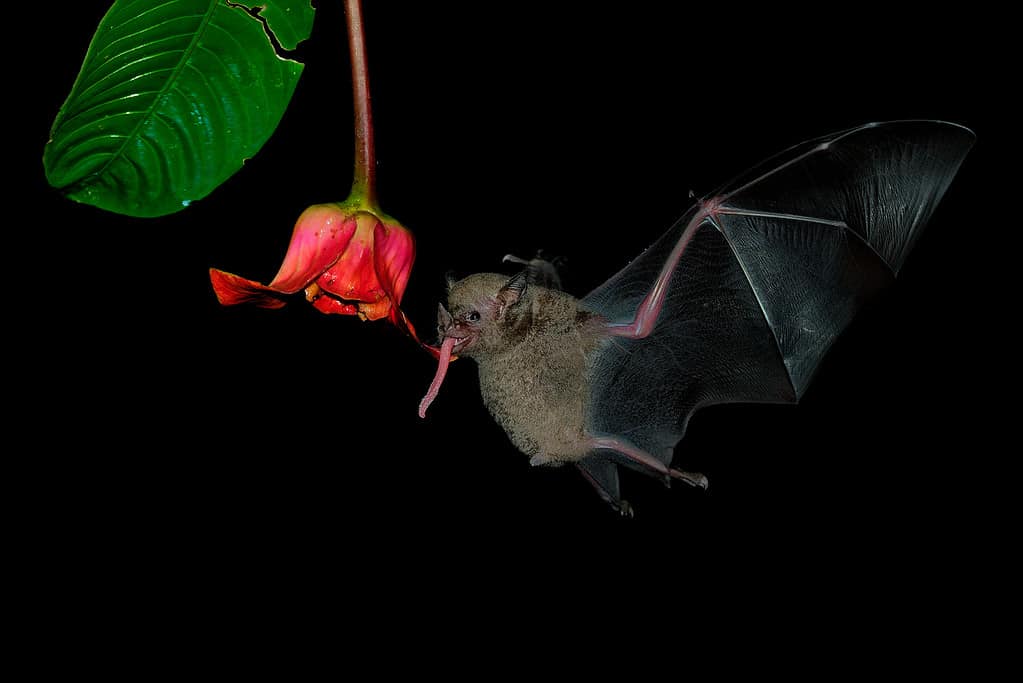
The tube-lipped nectar bat’s tongue is a marvel of nature, not only in terms of its length but also in its functionality.
©phototrip/iStock via Getty Images
3. Flickertail Goby
The Flickertail Goby, a tiny fish found in the Caribbean, possesses a tongue that is astonishing when compared to its diminutive body size. These remarkable fish can extend their tongues to lengths that are up to 2.7 times their own body length, a striking example of adaptation in the animal kingdom. This unusually long tongue serves a crucial purpose in their quest for survival. It allows them to reach deep into crevices and burrows in search of small invertebrates, their primary source of sustenance. By using their extended tongues, Flickertail Gobies can explore hidden nooks and crannies to capture elusive prey.
In their coastal habitat, where hiding places and burrows are in abundance, these fish have evolved to be efficient hunters. Their extended tongues enable them to thrive in a challenging ecosystem. Moreover, this highlights the diversity of strategies that exist in nature to secure sustenance. This adaptation not only ensures their survival but also underscores the intricate relationships between organisms and their environments.
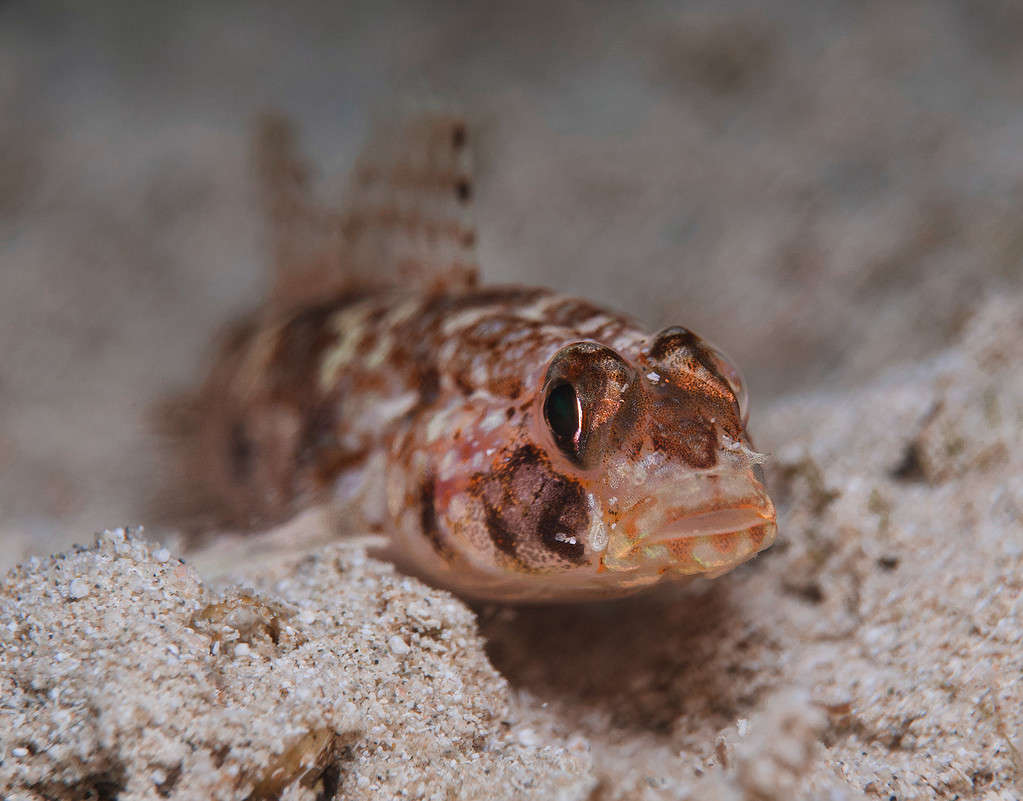
The remarkable tongue length of the Flickertail Goby is a prime example of how animals adapt to their specific environments.
©Sakis Lazarides/iStock via Getty Images
4. Sunbird
Sunbirds, known for their vibrant plumage and remarkable feeding habits, possess a tongue that is a biological marvel. The tongues of these tiny, nectar-loving birds can extend up to five inches, allowing them to access nectar-rich flowers with precision and efficiency. This adaptation is a testament to their specialized role as pollinators in various ecosystems, as their long tongues facilitate the retrieval of nectar from deep within the blossoms. Sunbirds play a critical role in the reproduction of numerous plant species as they flit from flower to flower. In doing so, they transfer pollen and support the rich tapestry of life in their habitats.
This crucial role in pollination underscores the ecological significance of these avian marvels. Sunbirds are not only a sight to behold with their iridescent plumage. They are also an example of how even the tiniest creatures can have a profound impact on the diversity and health of their ecosystems.

The elongated tongues of sunbirds are a testament to the intricate relationship between animals and plants.
©iStock.com/chirawan
5. Mantis Shrimp
The mantis shrimp, often considered one of the ocean’s most formidable predators, possesses a remarkable tongue-like structure known as a maxilliped. This specialized appendage is truly fascinating, and it can extend up to four inches in length. While not a traditional “tongue” in the sense of what we find in many animals, the mantis shrimp‘s maxilliped serves a similar purpose – capturing prey with astounding speed and precision. The mantis shrimp is a master of ambush hunting. With its barbed and spiky tips, the maxilliped is used to snatch unsuspecting fish, crustaceans, and other prey items. This exemplifies the intricate adaptations that marine creatures have developed to excel in their underwater environments.
The uniqueness of this structure underscores the adaptability of animals to their specific ecological niches. The mantis shrimp’s maxilliped allows it to exploit its environment to its full advantage, further highlighting the wondrous diversity of life in the oceans.
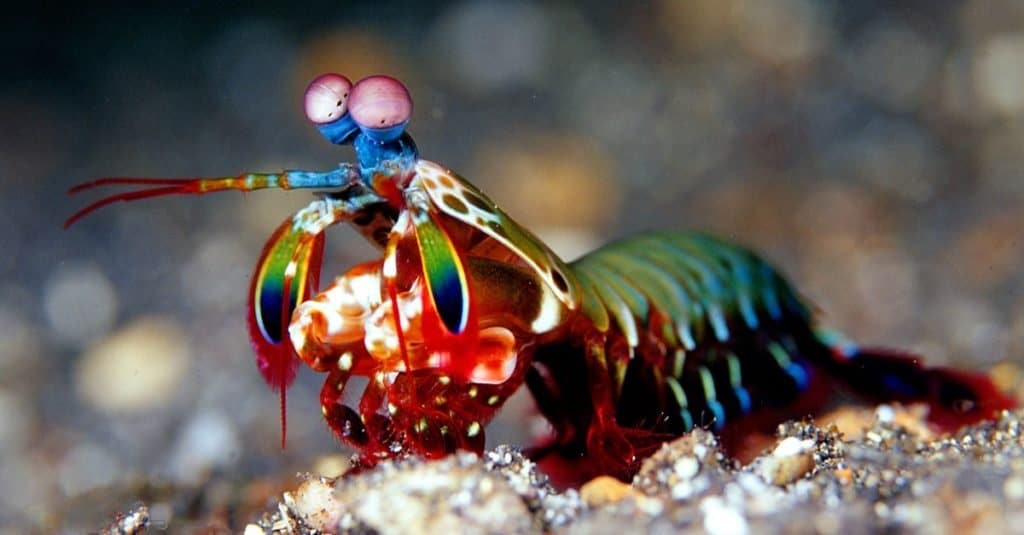
The mantis shrimp possesses a remarkable tongue-like structure known as a maxilliped.
©iStock.com/worldclassphoto
6. Woodpecker
The woodpecker’s tongue is a fascinating example of adaptation in the avian world. Unlike most bird species, woodpeckers have evolved a specialized tongue that is exceptionally long, reaching up to four inches in some species. What makes their tongues truly remarkable is their intricate design. They are not only long but also barbed and coated with a sticky, glue-like substance. What’s more, this allows woodpeckers to capture insects residing deep within tree bark. This adaptation enables them to be highly efficient hunters, extracting their prey from narrow crevices that are inaccessible to many other birds.
Woodpeckers, by leveraging their specialized tongues, are not only masters of capturing elusive prey but also instrumental in controlling insect populations in their forested habitats, making them vital contributors to the health of these ecosystems.

The woodpecker’s tongue is not only a hunting tool but also an essential part of its feeding strategy.
©abriggs21/iStock via Getty Images
7. Okapi
The okapi, a mysterious and seldom-seen forest-dwelling mammal, boasts a tongue of remarkable proportions in relation to its body size. Known for its striking resemblance to both a giraffe and a zebra, the okapi‘s tongue can extend to an impressive length of up to 14 inches. This elongated tongue serves as a vital tool in the okapi’s feeding strategy. It allows okapi to reach leaves and buds from low-hanging vegetation in the dense rainforests of Central Africa. All in all, the extraordinary length of the okapi’s tongue helps it access its primary food source. This, in turn, contributes to its survival in its lush and challenging habitat.
Moreover, the okapi’s extraordinary tongue is a testament to its biological adaptability. Furthermore, it is also a reminder of the intricate interplay between animals and their ecosystems, shaping the rich tapestry of life in the rainforests of Central Africa.

Okapi’s lengthy, agile tongue facilitates feeding in the densely canopied forest.
©wrangel/ via Getty Images
8. Giant Anteater
The giant anteater, an icon of Central and South American ecosystems, possesses a tongue that is nothing short of astonishing. With a tongue that can reach lengths of up to two feet, it is a true testament to the incredible adaptations seen in the animal kingdom. Covered in sticky saliva, this elongated tongue enables the giant anteater to probe deep into termite mounds and ant nests. In this way, the anteater can extract its favorite prey with remarkable efficiency. The tongue acts as both a sensory and feeding tool. This allows the anteater to detect and capture thousands of ants and termites each day.
This extraordinary adaptation ensures the anteater’s success as an efficient insectivore. Furthermore, it emphasizes the intricate ways in which animals have evolved to exploit specific food sources in their environments, ultimately contributing to the balance of nature.
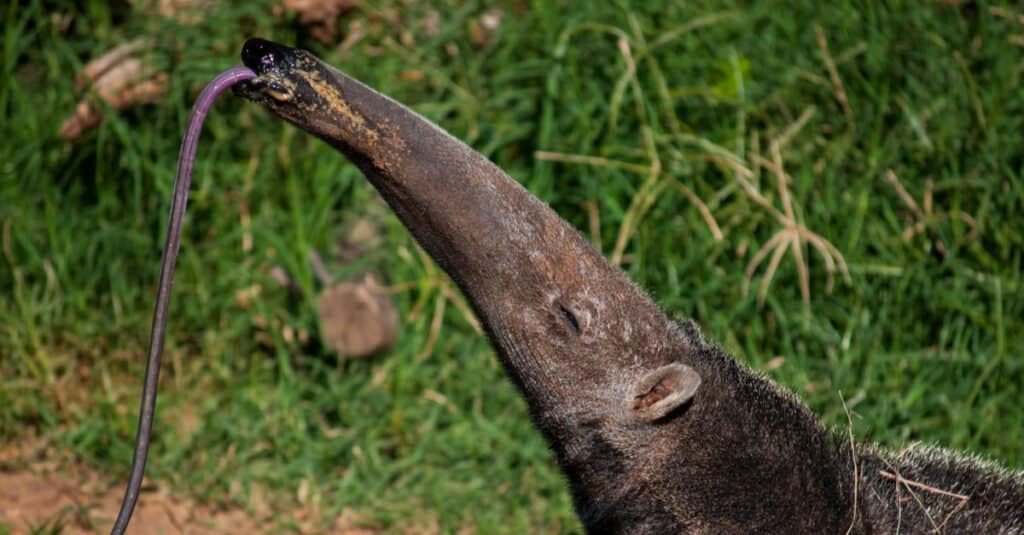
The tongue acts as both a sensory and feeding tool. This allows the anteater to detect and capture thousands of ants and termites each day.
©esdeem/Shutterstock.com
9. Chameleon
The chameleon, known for its remarkable ability to change color and blend into its surroundings, also possesses a truly extraordinary tongue. The chameleon’s tongue may not be the longest relative to its body size. However, it’s worth noting for its incredible agility and precision. The length of a chameleon’s tongue can extend up to 1.5 times its body length. This makes it one of the longest relative tongue lengths in the animal kingdom. This elongation is an essential adaptation for these reptiles, enabling them to be skilled hunters in their arboreal habitats. With a rapid and highly accurate strike, chameleons use their lengthy and sticky tongues to capture insects, small vertebrates, and other prey with remarkable speed.
The chameleon’s tongue length is a shining example of evolution’s fine-tuning for a specific ecological role. These reptiles have evolved to exploit a niche where quick, precise hunting is essential for survival. The elongated tongue is a highly specialized tool that allows them to capture prey with incredible accuracy, compensating for their relatively slow movements. This unique adaptation underlines the diversity of life on Earth and showcases how even small, seemingly inconspicuous creatures have developed extraordinary features to excel in their natural habitats.

The length of a chameleon’s tongue can extend up to 1.5 times its body length.
©Brenton Schappell/Shutterstock.com
10. Honey Possum
The honey possum, a tiny marsupial native to Western Australia, possesses a tongue that is an incredible adaptation for its unique feeding habits. With a tongue that can extend to lengths of up to 6.5 inches, this diminutive creature showcases nature’s ingenuity in exploiting nectar as its primary food source. The honey possum’s long, slender tongue allows it to access nectar deep within the blossoms of native Australian plants. This remarkable tongue length serves as a crucial tool for the honey possum’s survival. Furthermore, it highlights the intricate relationship between animals and the plants they rely on for sustenance.
The honey possum’s tongue not only aids in its own nutrition but also plays a vital role in plant reproduction. As the possum extends its lengthy tongue deep into flowers, it comes into contact with pollen, which it transfers between flowers as it feeds. This incidental pollination contributes to the continued growth and genetic diversity of native Australian flora. The honey possum’s tongue, therefore, serves as a remarkable example of coevolution between a species and the plants it depends on.
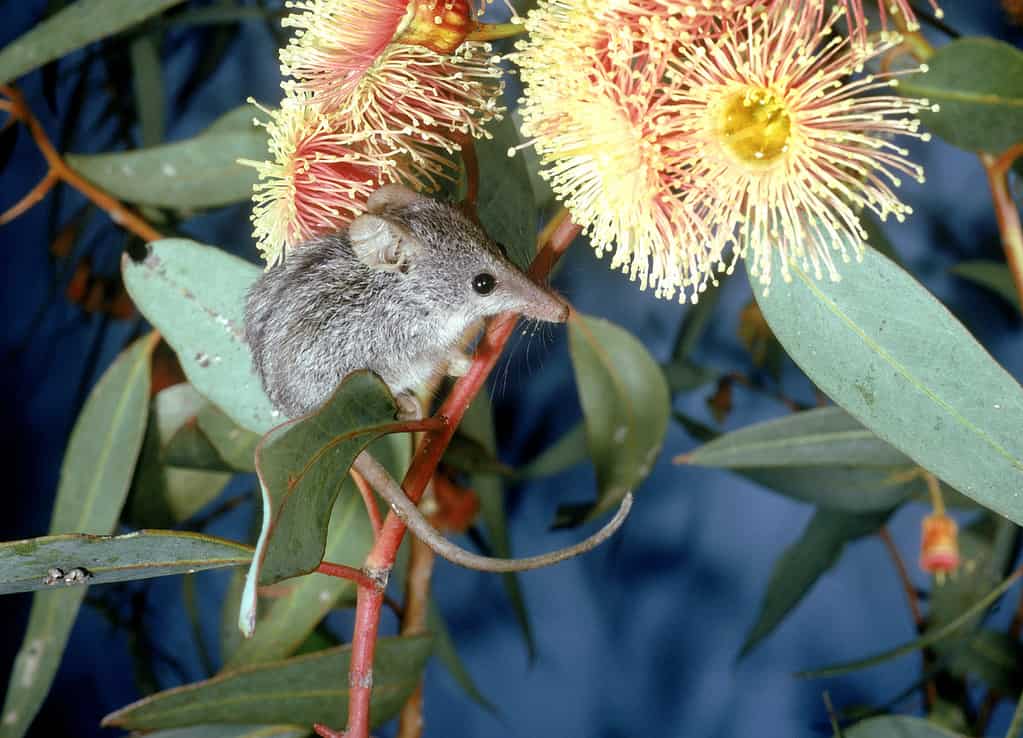
The honey possum exemplifies nature’s ingenuity in exploiting nectar as its primary food source.
©© Oxford Scientific/The Image Bank via Getty Images
11. Pangolin
Next up, pangolins, the world’s only fully-scaled mammals, possess a tongue that is truly exceptional in the animal kingdom. With tongues that can extend up to a remarkable 16 inches in length, pangolins have developed a highly specialized adaptation for their diet. These elongated tongues, coupled with their exceptional sense of smell, allow them to efficiently capture ants and termites from deep within underground burrows and insect mounds. Moreover, the tongue’s surface is covered in sticky saliva, enabling the pangolin to easily trap and retrieve its prey. This remarkable tongue length is a vital tool in their foraging strategy, making pangolins efficient insectivores while underscoring the unique and diverse adaptations found in nature.
Pangolins‘ extraordinary tongue length is not only a testament to their feeding prowess but also plays a crucial role in their ecosystem. By regulating ant and termite populations, pangolins help maintain the balance of insect communities, which, in turn, has broader ecological implications. All in all, these scaled creatures fulfill their essential roles as insectivores and contribute to the health and balance of their ecosystems.
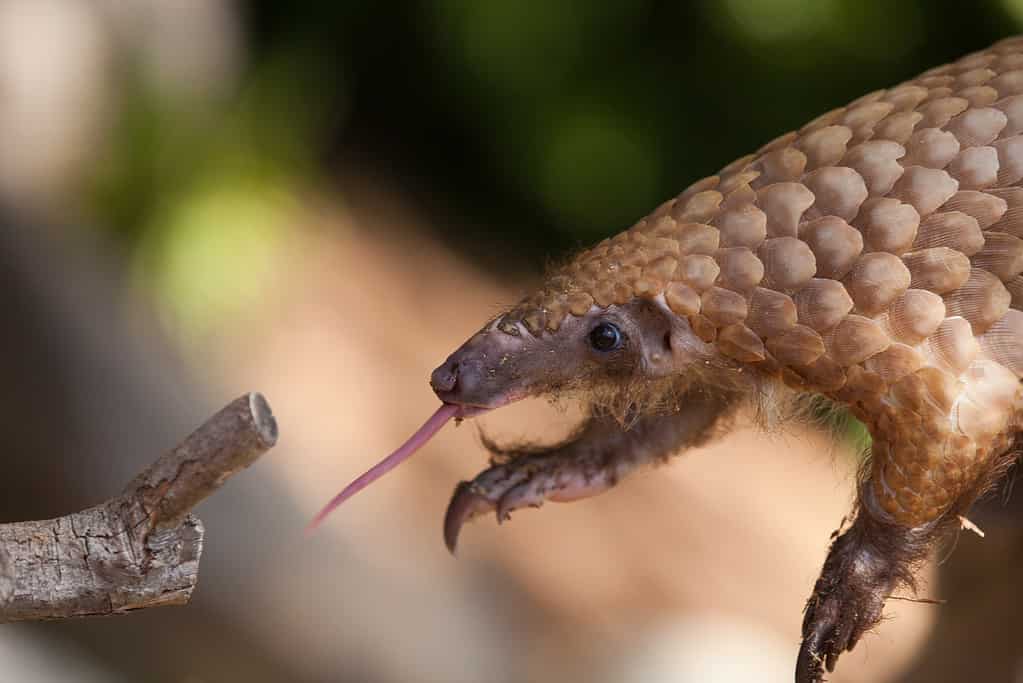
Pangolins’ tongues can extend up to 16 inches in length.
©DarrenBradleyPhotography/iStock / Getty Images Plus via Getty Images
12. Eastern Long-Necked Turtle
The Eastern Long-Necked Turtle, native to eastern Australia, features an intriguing adaptation in the form of its tongue. The tongue of the Eastern Long-Necked Turtle is noteworthy for its role in hunting aquatic prey. The tongue can extend up to 1.5 times the length of the turtle‘s head, which is particularly useful for capturing small fish, crustaceans, and aquatic insects. This remarkable tongue adaptation enables the turtle to be an efficient predator in its freshwater habitat. Moreover, it allows it to reach deep into narrow crevices and catch elusive prey. The Eastern Long-Necked Turtle’s tongue is a testament to nature’s ability to fine-tune adaptations that cater to the needs of a particular species. This, in turn, ensures its success in its aquatic environment.
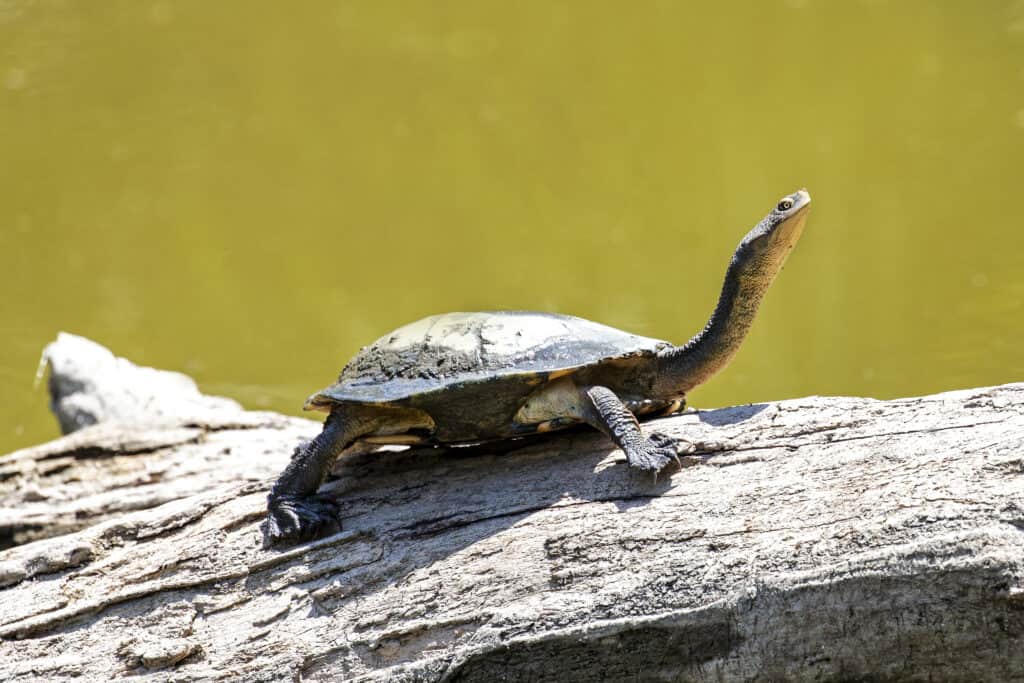
The tongue of the Eastern Long-necked Turtle is noteworthy for its role in hunting aquatic prey.
©iStock.com/Ken Griffiths
13. Woodpecker Finch
The Woodpecker Finch, native to the Galápagos Islands, possesses a unique and highly specialized tongue that is exceptional in its own right. The Woodpecker Finch‘s tongue can extend up to 2 inches. This might seem relatively short compared to some other species. However, this length is perfectly adapted for capturing insects hidden within tree bark. With its long tongue, the Woodpecker Finch can expertly reach into crevices to extract insects and larvae. All in all, its tongue is a proficient tool and a testament to the diversity of avian adaptations in its unique island habitat.
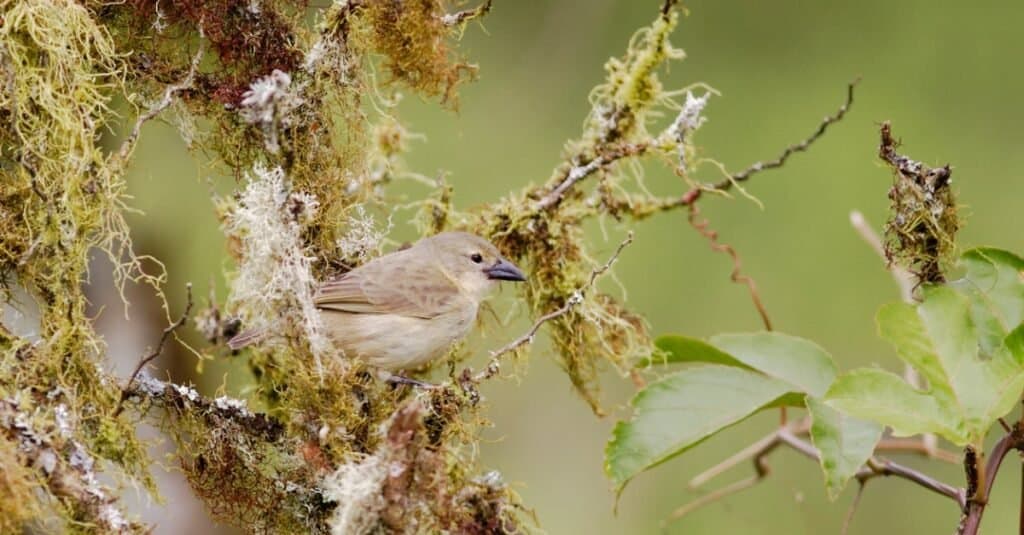
With its long tongue, the Woodpecker Finch can expertly reach into crevices to extract insects and larvae.
©Wilfred Marissen/Shutterstock.com
14. Sun Bear
The sun bear, the smallest among bear species, possesses a tongue that is remarkably long relative to its body size. This unique adaptation allows it to access food sources in the wild more effectively. The sun bear’s tongue can extend up to approximately 9.8 inches, notably lengthy for an animal of its size. This extended tongue is particularly vital for extracting insects and honey from tree cavities, which are some of its preferred food sources. By reaching into crevices and tree hollows, the sun bear is able to collect these nutrient-rich foods more efficiently. Moreover, this contributes to its survival in its Southeast Asian habitat.
The sun bear’s impressive tongue length is a demonstration of how animals can evolve specific adaptations to exploit their environments more effectively. The long tongue exemplifies the adaptability of species, even in challenging and competitive ecosystems. Who would’ve thought that a seemingly small anatomical feature could make a significant difference in an animal’s quest for sustenance?

The sun bear’s tongue can extend up to approximately 9.8 inches, which is notably lengthy for an animal of its size.
©Vladimir Wrangel/Shutterstock.com
15. Blue-Throated Hummingbird
The Blue-Throated Hummingbird, a bird species native to Mexico and parts of the southwestern United States, boasts a tongue that is as remarkable as it is essential for its survival. The tongue of the Blue-Throated Hummingbird can extend up to about 3.2 inches. This tongue length is crucial for these birds as they feed on nectar-rich flowers. Their slender, tubular tongues allow them to access deep-seated nectar sources within blossoms. This ensures that they can efficiently extract the sugary fluid that serves as their primary source of energy. This remarkable adaptation highlights the intricate coevolution between hummingbirds and the plants they pollinate. Furthermore, it emphasizes the importance of tongue length in their specialized feeding habits.
The Blue-Throated Hummingbird’s tongue exemplifies how specific adaptations can drive ecological relationships. The birds’ extended tongues facilitate precise nectar extraction. What’s more, as they feed, their heads come into contact with the flower’s reproductive parts, transferring pollen between blossoms. This pollination plays a critical role in the reproduction of the plants these hummingbirds feed on. The tongue length of the Blue-Throated Hummingbird is a prime example of the intricate web of interactions that exist within ecosystems.
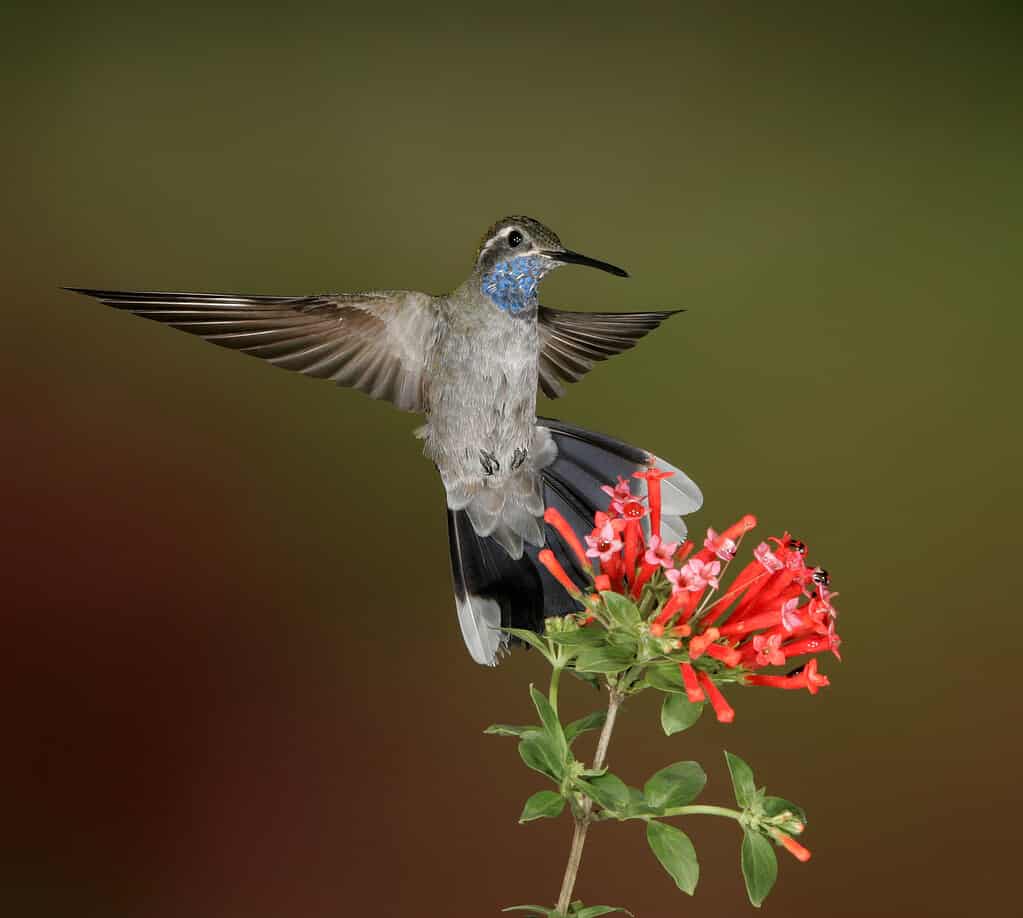
The tongue of the Blue-Throated Hummingbird can extend up to about 3.2 inches.
©Jedlovec/ via Getty Images
Conclusion
In conclusion, the animal kingdom abounds with remarkable adaptations, and the extraordinary lengths of these creatures’ tongues are no exception. From the colossal tongues of blue whales to the intricate feeding strategies of woodpeckers, each animal showcases the unique ways nature has equipped them to thrive. These exceptional tongue lengths are a testament to the diverse and ingenious designs found throughout the natural world. The next time you encounter one of these remarkable creatures, take a moment to appreciate their incredible tongues and the vital roles they play in their ecosystems.
| Rank | Animal |
| #1 | Blue Whale |
| #2 | Tube-Lipped Nectar Bat |
| #3 | Flickertail Goby |
| #4 | Sunbird |
| #5 | Mantis Shrimp |
| #6 | Woodpecker |
| #7 | Okapi |
| #8 | Giant Anteater |
| #9 | Chameleon |
| #10 | Honey Possum |
| #11 | Pangolin |
| #12 | Eastern Long-Necked Turtle |
| #13 | Woodpecker Finch |
| #14 | Sun Bear |
| #15 | Blue-Throated Hummingbird |
The photo featured at the top of this post is © DarrenBradleyPhotography/iStock / Getty Images Plus via Getty Images
Thank you for reading! Have some feedback for us? Contact the AZ Animals editorial team.







